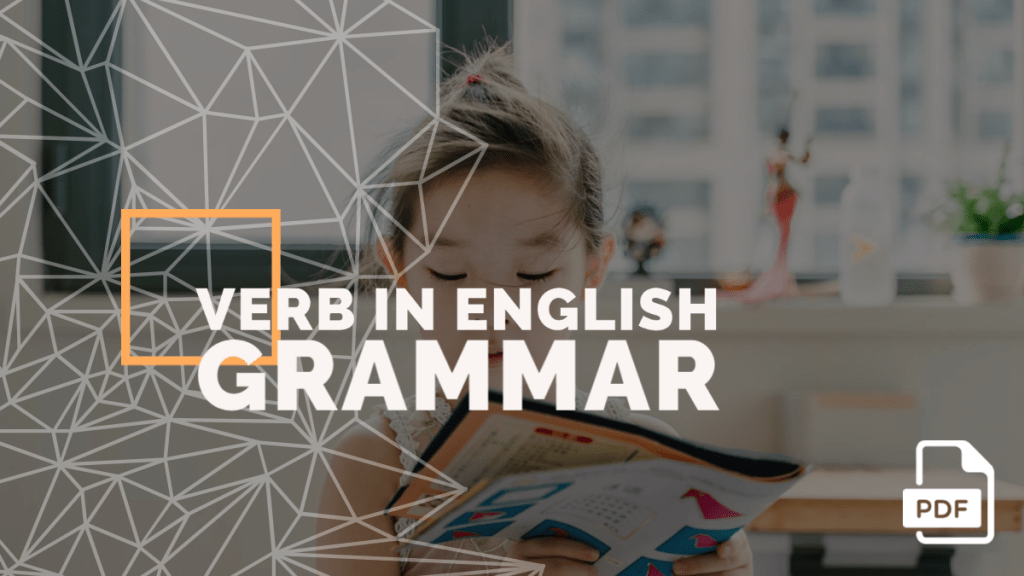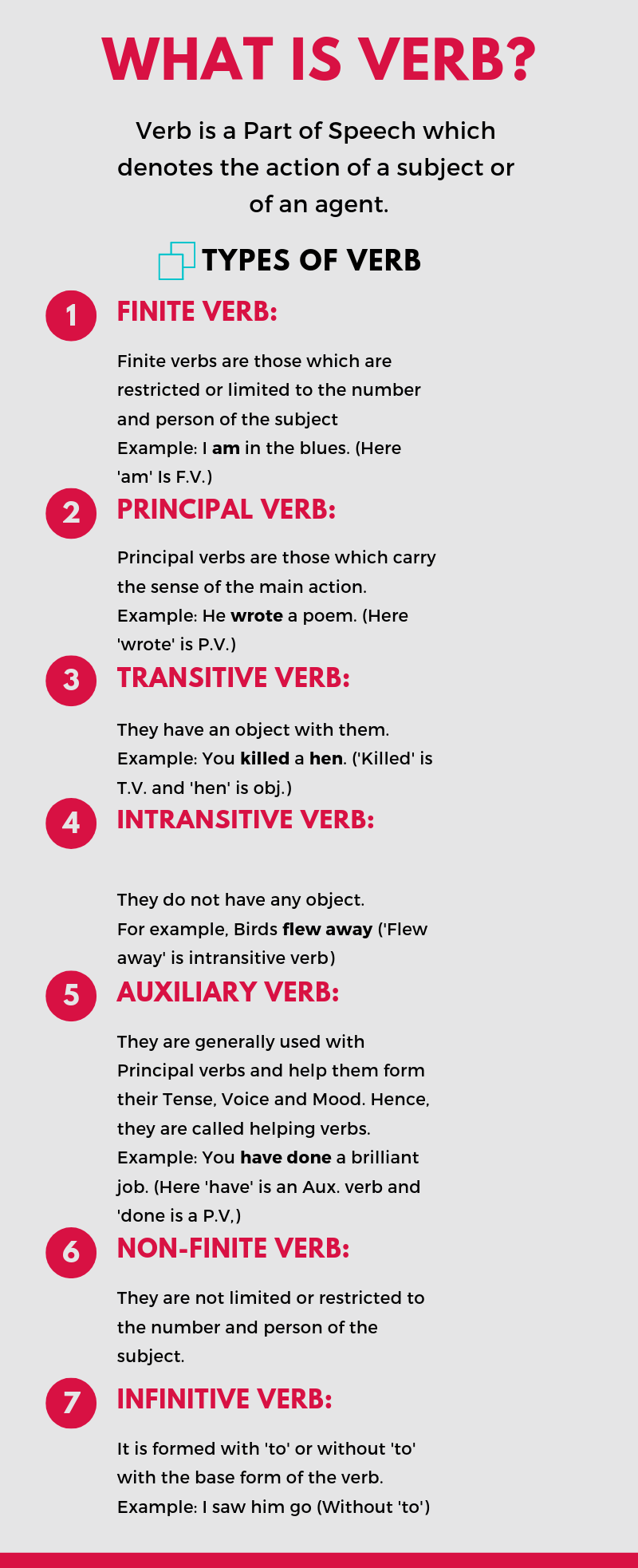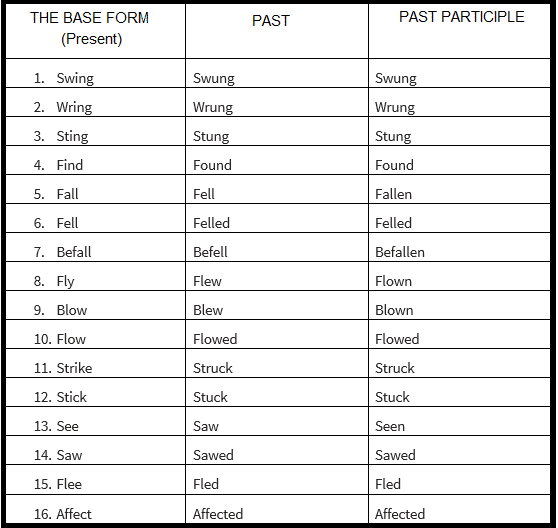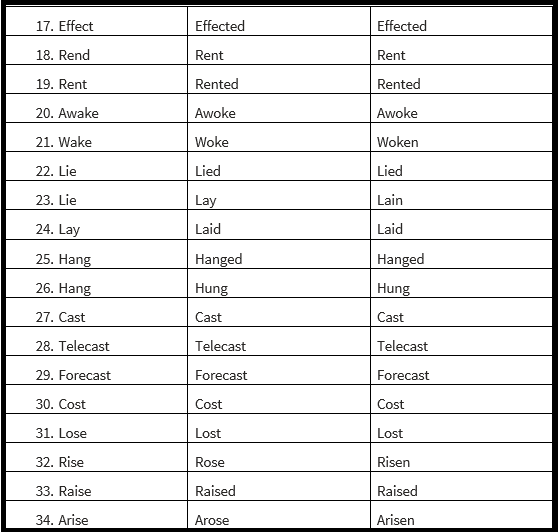Verb in English Grammar with Examples [PDF]
This is a complete guide of Verb in English Grammar.

Definition of Verb:
A verb is a part of speech which denotes the action of a subject or an agent and used to tell something about a person or a thing.
For example, John plays football.
Here the underlined word is a verb because the person ‘John’ performs an action i.e., ‘play’
So, let me show some examples.
What a thing or person is –
- My sister is an engineer
- She is the pretty village girl
What a person or thing does-
- He often visited his birthplace
- She teaches in our school
What is done to a thing or person is –
- He was punished
- Joyee was taught a lesson
HERE IS AN INFOGRAPHIC

Types of Verb:
There are seven types of verb and those are:
- Finite verb
- principal verb
- Transitive verb
- Intransitive verb
- Auxiliary verb
- Non-Finite verb
- Infinite verb

Finite Verb:
These are restricted or limited to the number and person of the subject.
For example,
- I am in the blues
Principle Verb:
It carried the sense of the main action.
For example,
- He wrote a poem
Transitive Verb:
They have an object with them. These are alone used in passive voice.
For example,
- You killed a bird (Here killed is a Transitive verb and bird is the object)
Intransitive Verb:
They do not carry an object with them
For example:
- Birds flew away (Intransitive Verb)
Auxiliary Verb:
It is generally used with principle verbs and help them to form their tense, voice and mood, therefore, these types of a verb are known as helping Verb.
For example,
- You have done a good job (Here ‘have’ is used as aux(v) and done is used as a principal verb.)
These are two types:
- Primary auxiliary and
- Modal auxiliaries
- Primary auxiliary:
These are ‘To be’, ‘To have’ and ‘To do’
Be: Present- is/ am/ are Past- was/ were Future- Shall be / will be
Have: Present- have/has past- had Future- Shall have/will have
Do: Present- do/does Past- did Future- Shall/will
Sometimes it uses with or without the help of principle verb.
For example,
- I have a car.
- I have done an excellent job.
Similarly, they are directly governed by the number and person of the subject
- Modal auxiliaries:
These are should, shall, will, would, may, might, used to, ought to need etc.
Features of modal auxiliaries are they are always used with principle verbs [External Link] (except ‘Dare’ and ‘Need’)
And remain unchanged in their form according to the person and the number of the subject (except ‘Have to’ and ‘Has to’)
Non-finite Verb:
These are not limited by the person and the number of any subject. They are used without mentioning any subject.
This is three kinds-
- Infinite
- Gerund
- Participle
For example:
- She comes here to study.
- we saw them waiting for the bus.
Gerund:
A gerund is called a type or kind of verbal noun which has double force both of a verb and an adjective.
For example,
- Walking is good for health.
Participle:
A participle [External Link] is called verbal adjective for it has the combined force both of a verb and an adjective.
For example,
- I saw the man swimming in the pool.
Infinite Verb:
It is formed with ‘to’ or without ‘to’ with the base form of the verb.
For example,
- To err is human
- I saw him to go. (without ‘to’)
Rules of Verb:
Rule 1
If only one article on possessive pronoun is used before the first noun when there are two nouns connected with ‘and’ it means that the two nouns are used for the same person or thing and the verb becomes singular.
For example,
- The principal and warden has come.
- My friend and adviser has come
Rule 2
If two article or possessive pronouns are used for both the subjects the verb becomes plural because it means that they are two different people.
For example,
- The principal and the warden have come
- My friend and my adviser have come
Rule 3
If two subjects (Nouns) convey a singular concept, the verb becomes singular.
For example,
- Rice and curry is a good meal for Bengalies.
- Honesty and Hard work is needed for success
Rule 4
If two subjects are joined with- ‘with’, ‘together with’, ‘as well as’, ‘in addition to’, ‘along with’, ‘no less than’, the verb follows the first subject (S1).
For example,
- The father (N1 S1) along with all his children (S2 N2) is going to see a movie.
- The five brothers (S1) along with their old father (S2) are moving to the new house.
Rule 5
If two subjects are joined with ‘either-or, neither-nor, or, not-only but-also’ the verb follows the second subject (S2)
For example,
- Either Ram or his brothers have done this.
- Not only he but also I am to do the work.
Rule 6
The verb after the relative pronoun follows the noun or pronoun just before the relative pronoun.
For example,
- I who am your brother should be love
Rule 7
‘None but’ and ‘nothing but’ always take singular verbs and the verb will follow ‘none’ or ‘nothing’.
For example,
- None but me is to blame.
- Nothing but students is there.
Rule 8
The verb is the following cases is used in singular form.
When two singular nouns after to the same person denoted by one article.
In certain phrases or idiomatic pair of words suggesting the same meaning, though not synonyms.
For example,
- The collector and District Magistrate are on a visit to the Jhargram today. (used ‘is’ place of ‘are’)
- What is the aim and object of his costly plan? (correct)
- The sum and substance of the passage is given below. (correct)
- Bread and butter are sold here. (correct)
- Bread and butter are difficult to earn. (correct)
Rule 9
- A number – Plural Verb
- The number – Singular Verb
- A majority – Singular Verb
- The majority – Plural Verb
Rule 10
When a plural noun conveys a singular concept, the verb becomes singular.
For example,
- 60 rupees is to divided among the boys.
- 60 miles is a long distance
Verbs and Their Forms:


A Must Watch Video on Verb:
Exercise on Verb:
Choose the most suitable alternative to make the sentence logical in sense
- The bridge _ up by the terrorist only last week
a. blowed b. was blowed c. was blown
- During the rainy season, this stream was _
a. overflowed b. overflow c. overflown
- _ our freedom fighter is in danger
a. Arise b. Rise c. Raise
- One is _ in duty to help the aging parents
a. Bound b. bounded c. binding
- The mother asked me _ the table for the guests
a. to lie b. to lay c. laid
In the following examples, pick out the verbs, complements, and object
- I saw John go home
- They found him guilty
- They laughed at me
- He is flying a kite
- I have no time
Conclusion
I hope you liked this lesson on Verb.
Now I would love to hear from you:
Did you find this article helpful?
Do you have any queries on verb?
Also, I would love to see the answers of the above questions, and I will check and correct those for you within 24 hours.
References [External Links]:
- Auxiliary Verbs | What Are Auxiliary Verbs? – Grammar Monster
- Modal Auxiliary Verbs and Principal Verbs – Differences